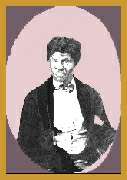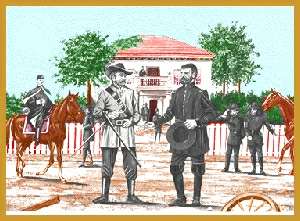| PinkMonkey Study Guide - American History
5. 4 Events Leading to the Civil War
Economic Causes
There were fundamental differences in the economy
of the north and the south of the U.S. Industry in the north demanded
fresh investments to seek more profits. While these drastic economic
changes were on in the north, the people in the south continued
to follow the life styles of their Scot, Irish and Welsh ancestors.
While the majority of the southerners owned no slaves and worked
on farms, a tiny section were big plantation owners. Because of
this fundamental difference, their interests often clashed. Says
historian Forrest McDonald: "The south advocated
a system of free trade among nations and a domestic policy that
did not invite much governmental interference in the economy;...it
largely succeeded in creating such a system and establishing such
a policy during the 1840s and 1850s..." On the other
hand, "the north...advocated high tariffs and active
governmental interference to promote economic development..."
The Elections of 1860
By the early 19th Century, the U.S. saw the consolidation
of the 2 party system. The Democratic Party, which had its support
base in the south, and the Republican Party, which had its support
base in the north. The election of 1860 brought the Republican candidate
Abraham Lincoln to the Presidential post. Lincoln had by this time
become a prominent figure in national politics. He championed the
cause of freedom.
Nullification Controversy
Due to the differences over the issue of tariffs
[Tariff of Abominations (1828)], relations became rather
strained between the north and the south. The bill forced many southern
Senators including John C. Callouh to demand the right of
the states to nullify any federal legislation that went against
the interest of the state. John C. Calhouh went a step further and
argued that states also have the right to secede from the Union.

Exhibit 5.4
Dred Scott
The Dred Scott Case
Dred Scott, a slave, had been bought from Missouri
into a territory which was free (no slavery) by the Missouri
Compromise. After some time, he was sent back to Missouri. Dred
Scott, after the sweet taste of freedom, did not want to become
a slave again. So he appealed to the Supreme Court for his freedom,
only to lose the case. The ruling of the Supreme Court against Dred
Scott caused an outrage in the anti-slavery camp. The Supreme Courtís
decision in the Scott case denying both the right of a slave to
sue for freedom and the right of a territory to exclude slavery
within its boundaries further inflamed the antislavery factions.
John Brown
The debates between the pro-slavery and anti-slavery
camp took a violent turn, when, in 1859, John Brown and his
men launched an armed revolt in Virginia - to abolish slavery.
John Brown was arrested and hanged for treason. But the incident
served to further ignite the debate on slavery. In such a volatile
situation the country went for elections (1860). The Republican
candidate, Abraham Lincoln was elected to the presidential post.
Lincoln had by this time become a prominent figure in national politics.
He championed the cause of freedom.
During the elections of 1860, the main issue
was slavery. The Democrat candidates were urged by southerners
to protect slavery. When no agreement was reached, the southerners
left. These southerners who supported secession from the Union,
nominated John C. Breckinridge of Kentucky. When the news
of Abraham Lincolnís victory reached South Carolina, it declared
itself out of the Union. This was because the southern state realized
that Lincoln did not support slavery. Florida, Georgia, Texas, Louisiana
and Alabama soon followed the decision made by South Carolina. Even
before the elections, the southern leaders felt that the north did
not accept their way of life. They realized that their economic
interests were being threatened in the Union.
These states which declared their secession, formed
a confederacy in 1861. They gave themselves a Constitution emphasizing
the statesí rights. Jefferson Davis was made the President,
with Alexander H. Stephens as the vice President.
The officials in the confederacy immediately seized U.S. military
installations.

Exhibit 5.5
Surrender of Lee
On April 12, 1861, the Confederate Cannons opened
fire, and Fort Sumter (the federal garrison) became the first battle
of America Civil War. The Confederate cause was slowly failing at
the face of superior northern co-ordination by railroads and the
marine. As the war dragged on, the Confederates realized they were
at the receiving end. The south had expected help from Britain.
However, Lincolnís envoy in London played an important role in keeping
Britain and other European powers out of the war. This further demoralized
the south. Finally, in April 1865, the Confederate General, Lee
surrendered to the Union army at Appomatox Court, Richmond.
With the end of the war, slavery and secession also came to an end.
[next page]
|
Table of Contents
5.0
- Chronology of Major Events in this Period
5.1 - Sectionalism
5.2 - The Anti-Slavery movement
5.3 - A brief account of the Domestic
scene on the eve of the civilwar
5.4 - Events Leading to the Civil War
5.5 - The Course of the
war
5.6 - Points to Remeber
Chapter 6
|